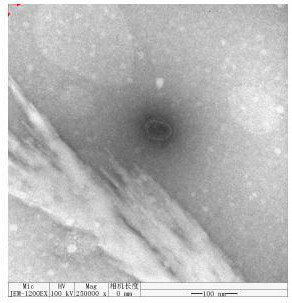Lytic vibrio parahaemolyticus bacteriophage RDP-VP-19003 and application thereof
A technology of RDP-VP-19003, Vibrio hemolyticus, applied in the direction of bacteriophage, virus/phage, medical raw materials derived from virus/phage, etc. Effect
- Summary
- Abstract
- Description
- Claims
- Application Information
AI Technical Summary
Problems solved by technology
Method used
Image
Examples
Embodiment 1
[0031] Example 1 Isolation and identification of Vibrio parahaemolyticus BV-19004
[0032] Samples were taken from the diseased sea cucumber lesions, using aseptic operation, streaked on TCBS medium, and cultured at 37°C for 18-24 hours, on the TCBS agar plate appeared round green colonies with neat edges and a diameter of about 2-4. mm; then pick a typical colony and streak it on the Chromagar Vibrio chromogenic medium. After culturing at 37°C for 18-24 hours, purple colonies appear on the Chromagar Vibrio chromogenic medium. Pick typical colonies and continue to streak Line purification was performed 3 times, and then a single colony was picked and inoculated in 5 mL of 2216E liquid medium, and cultured with shaking at 200 rpm at 37°C for 8 hours to obtain a uniform turbid bacterial suspension. Through 16sRNA molecular identification, it was identified as Vibrio parahaemolyticus, and one of them was named BV-19004.
Embodiment 2
[0033] Example 2 Isolation and identification of Vibrio parahaemolyticus phage RDP-VP-19003
[0034] The sewage sample used in the test of the present invention was collected from the surrounding sewage of farmers in Jimo, Qingdao in 2018, and was used as a water sample for the separation of bacteriophage.
[0035] Take 10 ml of sewage, centrifuge at 10,000rpm for 5 minutes, remove larger impurities and most of the bacteria, and then use a 0.22 micron microporous membrane to filter and sterilize. Take 3 milliliters of the filtrate and 3 milliliters of the host bacterial suspension, add them together into 20 milliliters of autoclaved LB broth, and then place them in a 37°C incubator for overnight culture. After culturing, take 5 ml, centrifuge at 10,000 rpm for 5 minutes, and then filter and sterilize with a 0.22 micron microporous filter. The filtrate is the stock solution intended to contain phage. Then, use the double-plate method to identify whether there are phages; pick ...
Embodiment 3
[0037] Example 3 Morphological observation of bacteriophage
[0038] Drop phage liquid (titer 10 10 pfu / m L) 100 μL, put the membrane side of the copper mesh on the phage droplet, take it off after 10 min, and let it dry naturally in the air for 2-3 min. Then drop a drop of 2% phosphotungstic acid (PTA) aqueous solution on the copper grid for staining, take it off after 10 min, dry it in the air for 10-15 min, observe with an electron microscope, and select a clear phage image to take pictures. Photo by electron microscope ( figure 2 ) It can be seen that the phage has no tail, is a regular hexagon, and the diameter of the head is about 55nm.
PUM
 Login to View More
Login to View More Abstract
Description
Claims
Application Information
 Login to View More
Login to View More - Generate Ideas
- Intellectual Property
- Life Sciences
- Materials
- Tech Scout
- Unparalleled Data Quality
- Higher Quality Content
- 60% Fewer Hallucinations
Browse by: Latest US Patents, China's latest patents, Technical Efficacy Thesaurus, Application Domain, Technology Topic, Popular Technical Reports.
© 2025 PatSnap. All rights reserved.Legal|Privacy policy|Modern Slavery Act Transparency Statement|Sitemap|About US| Contact US: help@patsnap.com



